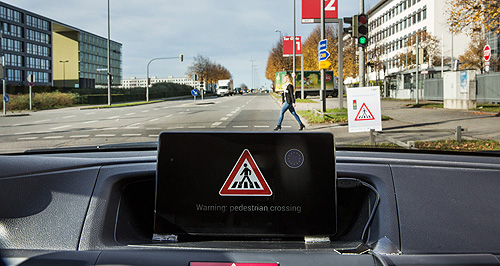News - General News - Autonomous TechnologyBid for intelligent transport CRCTalk to me: A co-operative research centre would help facilitate the introduction of vehicle-to-vehicle and vehicle-to-infrastructure communications. Co-operative Research Centre needed for introduction of smart roads, connected car30 Oct 2015 By IAN PORTER THE intelligent transport industry is preparing to bid for federal government funding to create a co-operative research centre (CRC) focused on developing systems needed for the technology’s smooth introduction on Australian roads. The systems to be developed will help facilitate the introduction of vehicle-to-vehicle (V2V) and vehicle-to-infrastructure (V2I) communications. Widespread adoption of intelligent transport systems (ITS) is expected to improve the efficiency of road networks and reduce the number of collisions, with the benefits estimated to be billions of dollars in both cases. Under the CRC program, companies and research institutions like the CSIRO and universities come together to solve particular problems, part-funded by a federal grant. The Turnbull government has reopened the CRC program and is expected to soon open a new round of bidding by candidates. The ITS community is preparing a bid that will be co-ordinated by the AutoCRC. If the bid is successful, the new research body would be called iMOVE (Intelligent MObility and Vehicle Evolution) CRC. The AutoCRC’s second grant period will expire in 2017 and it is anticipated that, if the ITS CRC bid is successful, the AutoCRC secretariat will be able to help the iMOVE CRC get off to a flying start. The peak body for the ITS industry, ITS Australia, has approached the AutoCRC for assistance in preparing the bid. There are more than 130 stakeholders associated with ITS Australia. “The whole ITS community wants to do something, so there is a need,” said AutoCRC chief executive Ian Christensen. According to Mr Christensen, the reopening of the CRC program would provide an opportunity to create a new CRC while the winding down of the AutoCRC’s current 49 projects would see experience and expertise become available. “So, there is a need, there is an opportunity and, inside the AutoCRC company, there is a quite well-developed capability to actually devise, implement and run a CRC,” he said. A company called AutoCRC Ltd has two subsidiaries, the AutoCRC itself and a company called Automotive Supplier Excellence. It is the company AutoCRC Ltd that would be helping the iMOVE CRC bid. “We thought, why not use this capability within the company to develop and run a much-needed intelligent transport CRC at a time when ITS Australia is very busy organising the ITS World Congress to be held in Melbourne in 2016,” Mr Christensen said. The iMOVE CRC would develop technologies to help reduce some of the costs inherent in the current transport system. They would aim to reduce car accidents, which cost an estimated $27 billion a year, ease congestion that is expected to cost $53 billion a year by 2031, and generally improve logistics and transport sector efficiency. Mr Christensen said the team putting together the iMOVE CRC bid was collecting expressions of interest from a wide range of prospective participants. These include state road authorities, trucking and logistics companies, companies with time-sensitive products, communities with mobility issues, road infrastructure companies, public transport operators and companies involved in communications, technology and data analytics. Mr Christensen said the next decade would see V2V and V2I help create a smarter, more productive transport system. “The technology and applications are evolving rapidly and this presents opportunities for Australia to participate in development and deployment of the next wave of products,” he said, adding that higher levels of connectivity and data processing would improve traffic flows and drive productivity gains. “Australia has companies that are at the leading edge of this transport revolution, including Cohda Wireless, Seeing Machines, Intelematics Australia and Transmax. “We also have some of the world’s best researchers in areas such as sensor development, traffic management, optimisation, telecommunications, complex systems, control systems and artificial intelligence.”  Read more15th of May 2015  Automated cars to require expensive infrastructureDriverless cars will change some of the basic concepts of motoring15th of May 2015  US trial to test how ITS and automation combineAutonomous transportation system could be operating in Michigan early next decade14th of May 2015  New tech enables road-funding trialTransurban to test driver attitudes to new ways of paying for roads |
Click to shareGeneral News articlesResearch General News Motor industry news |
















Facebook Twitter Instagram